#it’s a Godzilla movie of course but it is also a post World War II Japan movie and it is beautiful
Explore tagged Tumblr posts
Text

I made this in 30 minutes shut up. I needed to make art for this movie okay. Godzilla Minus One
#Godzilla minus one#bread#Godzilla#god this movie changed me#like legitimately when a movie can make me feel the way I did. god.#this movie is a masterpiece#it’s a Godzilla movie of course but it is also a post World War II Japan movie and it is beautiful
139 notes
·
View notes
Text
I've now seen Barbie twice and Oppenheimer once. They both left me with a lot of thoughts. It's also interesting how this cultural moment has got us comparing them due to releasing on the same day despite how different they are.
But not for the reasons we thought!!!
And I have my own thoughts!
I mean, yes, I knew going into Oppenheimer I was going to leave feeling heavy. I'm no expert on World War II history (I focused my history studies on the Cold War, and specifically Central/Eastern Europe), but we know the US bombed Japan, changing Japan forever. I've also watched the original Godzilla film in Japanese, Grave of the Fireflies, and plenty of other films focused on Japan's response to that traumatic and horrible experience. I can't shake all of that going into Oppenheimer.
I've seen some responses that the biopic goes too easy on Oppenheimer and the US, and while I never expected the film to have a specific anti-war bent (that would have been at odds with the person the film this is centering), it really effectively communicates the weight of the US possessing weapons of mass destruction. The pounding of the auditorium steps after the successful Trinity test, the shots of Oppenheimer imagining the audience dying as well as him stepping onto and breaking a charred body, the cacophony of cheers and terrified screams and stomping, and just...it was so, so much. I felt myself folding into myself, just so overwhelmed. It's such a good scene that carries through that emotional weight for the rest of the movie as Oppenheimer transitions into strongly advising against creating the hydrogen bomb in a race with the USSR. Not to mention all of the tension that underlies all US politics post-WWII in the era of McCarthyism, which still influences us today. Oppenheimer is not an easy film to watch.
But it's also strangely dreamy. Oppenheimer was a man who was wrapped more in ideas than in people themselves, and there are so many unreal, beautiful shots of particles, ripples on water, etc. There are also plenty of awesome (in the old sense of the word) shots of violence and impact from the atomic bomb.
Oppenheimer as a film is both complicated in how it portrays a complicated man, but it's also pretty straightforward in its morals and messaging, whereas Barbie hit me in ways I wasn't really expecting.
Barbie starts off incredibly dreamlike, and it sells the fantasy of Barbieland very well. The willingness to commit to the bit is one of the film's strengths in how it depicts that world (and then Kendom). But the movie, in my opinion, becomes less about Gender and more about our place in the world. Yeah, you can look at that through a gendered lens (both for the Barbies and for the Kens), but it's Margot Robbie's Barbie who decides to become a Creator, a Dreamer and not the Idea that others make. There's actually something very powerful about being an idea, but people will always be more complicated than ideas (maybe that's Oppenheimer the character's issue with women?). On her first foray into the Real World, Barbie sees that things are nowhere near as sunny as she expected. Women are of course not treated well, but even beyond that, from her spot at the bus stop, she sees a couple fighting, kids playing, two men laughing together in joy, and a person in intense concentration, ambiguous to me as to whether he's reading something and focusing or grappling with a heavy decision internally. The complexity of the world hits her as a tear rolls down her cheek (and mine!!!).
When I talk to people about Barbie, we all have such different thoughts on the film--especially for us women, nonbinary people, and both trans men and trans women. The doll is such a huge part of our culture and impacted us in different ways. Barbie has a complicated history that Greta Gerwig actually does a pretty good job of addressing. The Oppenheimer movie does not particularly look at the atomic bomb and its history with the same level of complexity; rather, Oppenheimer himself pivots from singlemindedly leading the research and creation of the bomb "for science" to then later singlemindedly protesting the hydrogen bomb. Yes, it shows him as a human capable of changing his mind, but doesn't get into the more specific nuances of it. He's first very for the atomic bomb and then very against the hydrogen bomb. Barbie, on the other hand, represents SO MUCH. Femininity both as power and as critique. Being everything (all of the different Barbies as a group) vs being one thing (Barbie as an individual, the character; made for a specific idea). Barbie as the trappings of gender roles vs. Barbie as uplifting. Barbie is everything, good and bad.
Yeah, there are issues with both films. Oppenheimer has some very weak dialogue, and Oppenheimer himself is, uh...problematic, as we say? Barbie has pretty paper thin Feminism 101. It never gets into how capitalism specifically impacts feminism and seeks to uphold gender roles and gendered expectations. It's definitely not Marxist, h aha. (But I also never expected it to tackle that. After all, it's still produced by Warner Bros and Mattel.)
I didn't expect Oppenheimer to be so dreamlike. And I definitely didn't expect Barbie to give me so many emotions about mothers and daughters and becoming your own person, going beyond the story made for you. That's what made me cry in Barbie during the final montage of childhood memories from all the staff/cast members on the project.
#rose rambles#rose reviews#I guess we're making that a tag now for me to ramble about stuff I watch and play#not so much a review-review as it is just my rambley thoughts#oppenheimer#barbie
3 notes
·
View notes
Text
GOJIRAAAAAAAAAAAA Blog Post

Godzilla is so iconic that I was scared the original wouldn't live up to the hype, but I'm happy to say I really enjoyed this film. I watched this movie a bit late, after our class session. Summarizing the movie for me, my discussion partner Zander said that it never lingers. When I finally got around to watching the film, I understood exactly what he was talking about. This movie has some amazing pacing. The plot moves quickly, and individual scenes are mostly quite short, without long or dramatic poses. My ADHD brain loved this film for that reason.
As for Godzilla the monster, I was quite impressed by the practical effects. The big lizard's first reveal on Odo island was genuinely pretty tense, even though the monster itself looks sort of goofy by modern standards. On his own, Godzilla isn't that scary, but the terrified reactions of the actors to his presence really sells him as this unstoppable force of nature. Godzilla's carnage in Tokyo is also scarier than the destruction we see in modern films, for a couple reasons. During these scenes, the camera tends to focus on smaller groups and individuals (a mother holding her daughters, for example) rather than the massive fleeing crowds directors today are fond of. It makes the destruction feel more real and personal, rather than just bombastic. Even before Godzilla reaches Tokyo, we see him crush a house on Oto island, and watch a mother cower under the sinking roof-- a tragic scene that is reminiscent of World War II. Another reason these scenes are so scary is just how they look: the pitch black skies of Tokyo, the deep shadows everywhere, the walls of flame. Its a genuinely nightmarish atmosphere. The production in this movie is just on another level-- there are so many cool locations and shots. The scene at the hospital after Godzilla's first attack on Tokyo was especially impressive, and, of course, heartbreaking.
Anyway, my classmates have already commented on a lot of the political commentary with H-bomb testing and the cold war arms race, but one part I thought was especially interesting was the decision to initially keep the existence of Godzilla from the public after it was known that H-bomb tests had likely roused him from his slumber. The politicians were wary of disturbing relations with the US, something that illustrates the unequal nature of the two countries relationships during this period. Indeed, it was only because of that unequal relationship that the US was able to conduct tests at all.
Anyway, really enjoyed this movie.
0 notes
Text
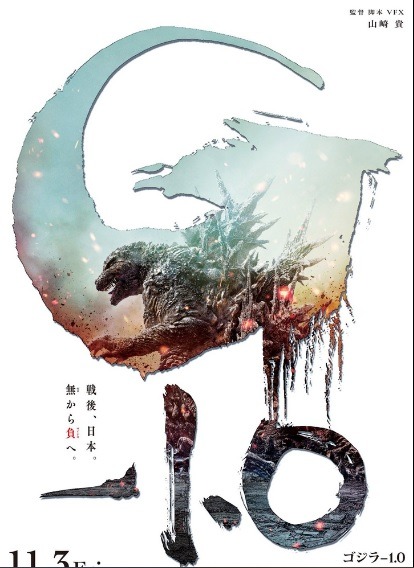
So yeah we finally went to see Godzilla Minus One I was a little upset in the beginning being this was a somewhat limited release at the start and being I'm a huge Godzilla fan for pretty much all of my life (thanks to my Uncle because he is a fan of the Kaiju movies) I couldn't see it because it wasn't playing here so like I said I was a bit upset and was going to wait until it came out on disk like I did with Shin Godzilla but thanks to Godzilla Minus One's exploding popularity and it becoming a box office hit so to speak they started screening it here so I was of course super happy about that and we had to go see it!
As for the movie itself I thought it was excellent it is a somewhat re imagining of the original Godzilla from 1954 and it works so well as it bring Godzilla back to its very beginning where he is once again an unstoppable force of nature in post world war II Japan.
The story basically revolves around this guy who is a failed Kamikaze pilot who returns home to the ruins of his town after experiencing a strange encounter with some type of giant monster on an island at the end of World War II As he returns home he suffers survivor guilt and even possible PTSD as he tries to build his life back after what happened and ends up with a somewhat make shift family and friends and then the unthinkable happens and the strange creature from the island shows up know as Godzilla and begins wreaking havoc on an all ready crippled Japan and it becomes a bit of a man vs nature type of thing as they ban together to find a way to stop this seemingly unstoppable force.
Now the movie was I felt very serious in its tone there where a few moments that that gave me a bit of a giggle and a couple that felt like it was over acted but it does go Back to Godzilla being an allegory/metaphor for nuclear weapons
other then that the acting was very good everything was pretty much perfect in this movie the production design, camera work, directing, writing and even the music is perfect and especially the visuals will capture you in awe and brilliance.
Every time Godzilla was on screen it gave me chills of excitement! from his first appearance on the island to him tearing apart Japanese cities and finally the final battle in the ocean. I loved his look it was a blend of both classic and modern and how his I guess you would say "powers" work was excellent the I guess you would say the somewhat "Jaws" scene where the bomb explodes in his mouth and you see his regenerative healing factor in action and I also like how they did his atomic breath/Heat Ray where it has this amazing build up where crawls up his back spines but in his each spine pops out a bit and before he uses it he takes a big deep breath and you can see it almost sparkle around his mouth as he inhales like the air is electronically charged around him I feel this build up makes it more devastating on screen and it shows it. its almost like a nuclear exposition leveling everything in its path.
but in the end the movie is amazing! and any Godzilla fan should see it and will probably love it like I did. but surprisingly there was one person who didn't when we were leaving after the movie there was one woman who was complaining rather aggressively that the movie was in Japanese and had subtitles you should have known that going in what did she expect? anyway I loved it and the person I went with like it as well so that is all that mattered to me.
youtube
#Godzilla Minus One#Godzilla#Godzilla Movies#NaughtyGirl286#ShannonJ286#Godzilla Films#Godzilla Movie Series#Godzilla Film Series#Godzilla 2023#Godzilla Minus One 2023#Youtube
0 notes
Text
May 4, 2021: The Host (2006) (Recap)
NO NOT THAT ONE
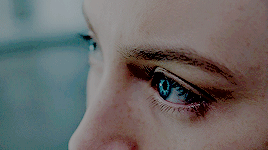
Stephanie Meyer goddamn sucks. I realize that I’m not exactly the first person to say that, but she’s terrible. Not only is she not a good writer, but she also has some very disparaging views about science fiction and its fans, which led her to make her own science fiction book and film. ANd yeah...it’s terrible! No surprise there.
So, no, not the 2013 critical and commercial flop known as The Host. No, this post is about 2006′s The Host, AKA Gwoemul, AKA 괴물. I haven’t ventured to far into the world of Korean cinema, and with this film, my repertoire includes only the films of director Bong Joon-Ho. And if that name sounds familiar...it should.
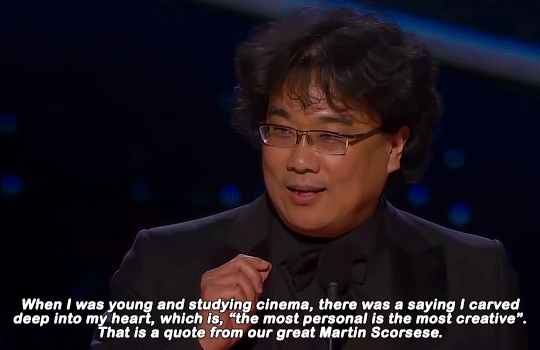
Bong Joon-ho DESERVEDLY made headlines last year when his film became the first non-English language film to win for Best Picture, and the first time Asian writers won for best screenplay! His Oscar speech in accepting best director is genuinely one of the best and most sincere speeches I’ve ever heard from a director, and I love the dude.
Oh, and if you’re wondering which film it was, then, like me, you also really need to watch Parasite. And because I’m terrified of spoilers, I’m not gonna look for GIFs of that movie. Instead, I’ll put in a GIF of one of my favorite sci-fi films, and the only other Bong Joon-ho film I’ve seen.

God, I love Snowpiercer. And if this is anything like that, I’m probably going to love this movie. Now, I don’t really know much about this film, other than the fact that it’s a monster film. And if there’s any science-fiction subgenre more iconic than monster films, I don’t know it. Well...OK, aliens, robots, and more, but monster films are still a big part of the genre. But where does that begin? Is it here?

Definitely an argument you can make, since Frankenstein’s Monster is a creation of science gone wrong, from the book to the movie. Fun fact, Mary Shelley based it on a real-world experiment by Italian physiologist Giovanni Aldini, who used a corpse to illustrate the connection between electricity and muscles. Neat, huh? So, yeah, that’s a solid launching point.
But that’s more of a horror story. What about something a little more monster-y? Well, from the UK to Japan we go!

OHHHHHH YEAH, THAT’S THE GOOD STUFF
Toho’s 1954 film Gojira is one of the most classic monster films ever made, and singlehandedly launched the kaiju genre in Japan. And it’s really well-known that it was made as a response to post-World War II tensions about nuclear warfare. Which, in Japan, is kind of understandable, no? But nothing demonstrated the destructive power of science more than that moment in history.
So, Godzilla arrives. And the US also makes more monster movies, most of which take place in contemporary settings, making many of them lo-fi sci-fi. Now, some dipped into horror or fantasy, but the science fiction roots were there. Which eventually would bring us full circle to films where monsters were made and go loose. You know, like this:
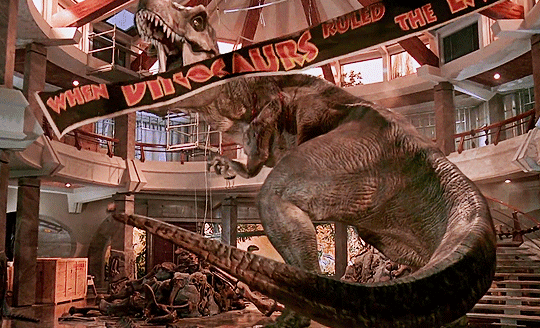
It’s a franchise that defines the ‘90s, and lab-grown monster movies exploded around that time as well. At the same time, environmental concerns REALLY started to build by this point, and those concerns leaked profusely into film all over the world. And by the time we get to 2006...well, let’s get into it, huh?
SPOILERS AHEAD!!!
Recap

In a mortuary, a U.S. military doctor (Scott Wilson) instructs his assistant (Brian Lee) to dump bottles of formaldehyde down the drain of the facility, which goes directly into the Han River. The assistant protests, but the doctor insists, despite the risk of polluting the river. AAAAAmericans.
In the river about two years later, two fisherman see something strange looking in the river. Then, four years later, in 2006, a suicidal man is about to jump into the river, when he sees something dark in the water below.
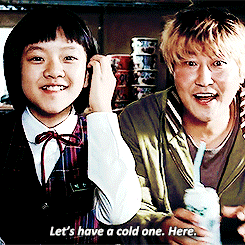
Later that year, we meet Park Hee-bong (Byun Hee-Bong) and his son Park Gang-du (Song Kang-ho), who run a food truck and snack bar near the river. Gang-du’s not exactly a hard worker, to his father’s chagrin. His daughter, Hyun-seo (Go Ah-sung), is a student who comes home from school, where her drunken uncle Nam-il (Park Hae-il) comes to her chagrin. She and her father watch TV, where his sister Nam-joo (Bar Doona) can be seen competing in archery.
As he’s bringing food out to customers, he joins them in observing something strange and massive hanging off of the bridge. And at this point, I would be running the fuck away. Literally, the news just said that there was a body found with the legs missing, and these people are throing cans at it after it plunges into the water. One girl asks if it’s a dolphin. Mother...HAVE YOU SEEN A DOLPHIN BEFORE?
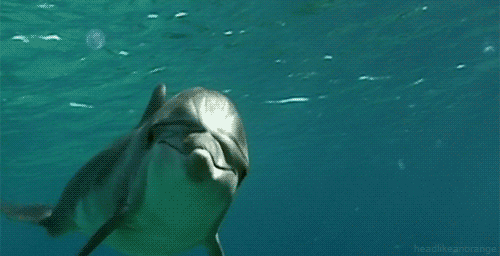
NOT THIS
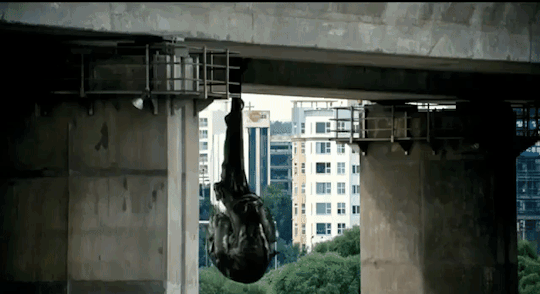
Yeah, this thing just comes bounding along the shore, slapping people into the water with its tail, and batting aside others. Doesn’t look like its actively killing anybody yet, but it’s definitely hurting people at least. That is, until it goes into a trailer where a bunch of people have gathered, and appears to eat a bunch of them. So, yeah, dangerous.
Gang-du, to his infinite credit, actually attempts to confront and hurt the creature, with the help of Donald White (David Joseph Anselmo). And it works, but at the cost of the creature aggro-ing onto him. Back at the snack truck, his sister’s lost the title, much to the chagrin of Gang-du’s daughter and father. She goes outside in frustration, only to be thrown into the midst of the chaos with her dad. He grabs a girls hand in the chaos, only to find that it’s a different child entirely. And...unfortunately...
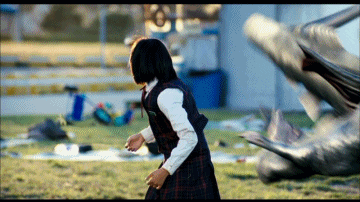
The creature grabs her with its tail, and leaps back into the river, disappearing. Fuck. Poor Hyun-seo, and poor Gang-du. Gang-du IMMEDIATELY goes to get her back, jumping into the river, but the creature takes her across to an island, out of reach. That night, an impromptu funeral is held for the victims, at which Hyun-seo is being honored as well. There, both Gang-du’s sister and brother also attend, and all four of the break down dramatically and publicly.

Nam-il blames his brother for letting her die, which is unfair, but understandable. The family eventually calms down and discusses the circumstances of Hyun-Seo’s birth and death, both of which were accidental. As they do, a man in a protective suit comes out, and asks who was at the river incident. Nam-il protests this, and asks what’s going on. The man doesn’t explain, and the room is instead gassed, as everyone is ushered towards the entrance.
In the process, Gang-du (stupidly) reveals that he was hit by some blood splatter. He’s immediately stuffed in a bag and kidnapped by the authorities. Meanwhile, the news reveals that the creature is carrying a virus, and anyone who has been in contact with it has been infected. Because of this, the entire family is taken to a quarantine hospital, which oddly has very few actual quarantine procedures in place. And additionally, Gang-du is feeling a bit itchy.

That night, in the hospital, Gang-du gets a call on his cell phone! It’s Hyun-seo! She’s alive! And she’s trapped, in a sewer somewhere near the river. Meanwhile, a group of men in protectve suits are outside patrolling the river. One man finds money on the side of the road, and goes to pick it up, only for the men to be attacked by the creature. But it’s then that we discover that the creature is not killing or eating people, but simply taking them own to its lair. Also in said lair is Hyun-seo, trapped and with a now dead phone.
The next day, the family tries to get an officer to look into the call, only for the officer to be, frankly, an absolute piece of shit to this grieving family. Gang-du tries to explain, and his explanation is ENTIRELY RATIONAL, but the officer and doctors are absolutely terrible about it.
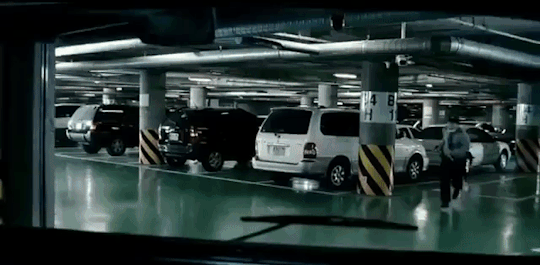
Because nobody’s listening, the family manages to escape from the hospital in order to try and save Hyun-Seo, and they hop into a van, taking it and running. This is a good place to mention that, despite this being a monster movie, it's also...weirly funny sometimes. Like, that whole scene is pretty great. After bartering with a group of gangsters for supplies (and after Hee-bong basically gives away all of his credit cards), the group manages to get a map and a new car. But they pretty quickly get stopped at a checkpoint into the city, and are nearly caught, but manage to escape and get to the riverfront. Once there, they begin searching the sewers to find Hyun-seo. And I gotta say; this may be an extremely dysfunctional family, but they’re a devoted family all the same.
Of course, that eventually gives way to arguments within the sewer itself, but that’s interrupted by a noise heard somewhere around them. They fire at it, using weapons obtained from the gangster but conclude that it was nothing. What it actually is is two brothers, older Se-jin (Lee Jae-eung) and younger Se-joo (Lee Dong-ho), homeless kids who are foraging the sewers in the abandoned city. But, of course, they eventually run into the creature, which attacks them. Meanwhile, an asleep Hyun-Seo dreams of dinner with her family, only to be woken up by the arrival of the creature, who deposits the bodies of the two boys in the sewer with her. Se-joo has survived, but Se-jin hasn’t, sadly.
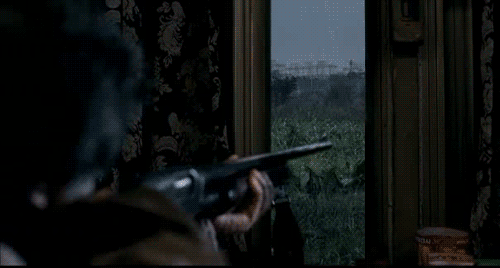
Meanwhile, the rest of the family is gathered at their snack bar for the night, and prepares to set out or the morning. The to younger siblings appear to not give a single shit about Gang-du, but Hee-bong attempts to set them straight, talking about how he blames himself for the way Gang-du is now. However, the two just fall asleep during his speech. Poor Hee-bong. Also, he can apparently identify Gang-du’s health condition based on his farts because they spend so much time together, it’s dumb, and funny.
Also, poor the rest of them, because Gang-du wakes up to see the creature just waiting outside, watching them. Hee-bong fires at it, but the creature attacks and knocks over the bar. However, Hee-bong manages to hit it directly in the head, knocking it off, but not killing it. The family goes out to finish the job, but it runs away before they can kill it. They run after it, and are almost completely out of bullets. Hee-bong volunteers to go after it himself, but in the process...
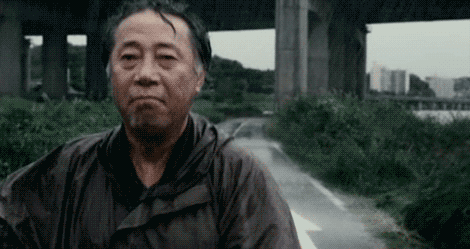
Hee-bong doesn’t make it. The creature kills him, and the commotion attracts the military to their location. Gang-du is again captured, while Nam-il and Nam-joo escape, only to later be separated regardless. Meanwhile, the virus kills Donald White, the sergeant from earlier, and it continues to spread across Korea. To kill the creature, the government plans to release a chemical into the river called Agent Yellow, which feels...controversial.
Nam-il meats a colleague, “Fat Guevara” (Yam Pil-sung), who is easily able to provide a location for Hyun-seo using the number, which the cop earlier insisted was nearly impossible to do. Plus, both the sergeant and Gang-du encountered the creature together, and he seems to be just fine. Which probably means that something very wrong is happening now. Even worse, though, is the fact that Guevara’s appeared to trap Nam-il, as a massive reward is sought for his arrest. A gang of people surround hi, with the plan to capture him, but he VERY cleverly escapes by causing an electrical short, and AFTER having found Hyun-seo’s location! Nice, man! He takes off, now knowing exactly where his niece is.
Nam-joo, meanwhile, is literally living inside of the snack bar, and she gets a text from Nam-il with her location. He tags out, and she tags in, running to the location where the call came from. But she immediately runs into the creature, which knocks her down and unconscious. She manages to call Gang-du, who is currently about to be sedated. Now knowing where his daughter is, he tries to escape, only to be tackled by the doctors. He tells them where she is, but they don’t appear to listen. More importantly, the anesthetic doesn’t appear to work, much to the confusion of the doctors. Something is verrrrrrrry wrong here.

An American doctor (Paul Lazar) comes, and asks what’s wrong, and he tells him exactly what’s wrong. However, despite his words SEEMING to be heard, they once again call him crazy and delusional, and decide to give him a lobotomy to isolate the virus once and for all, like FUCKING ASSHOLES. Turns out that the virus? Yeah, it doesn’t exist whatsoever! It doesn’t exist even a little bit! Which means that this entire thing is a wild goddamn goose chase for a virus that DOESN’T FUCKING EXIST!!!
And the best thing is that Gang-du, despite not actually knowing English, still understands the words “no virus”, and know he fucking knows! However, because he knows, they now have to give him a lobotomy. Fuck me, man. Panicking, he cries for them to stop, and cries for his daughter, who’s still alive in the sewer.
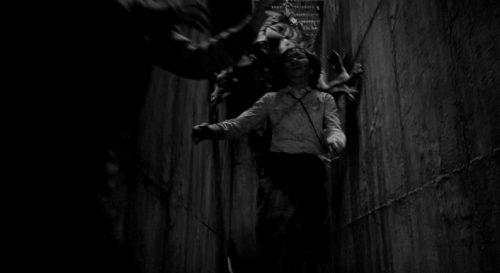
Speaking of, Hyun-seo and Se-joo are bonding in the sewer, as they work to make a rope from things they find there. But in the process, they’re attacked by the creature, who know is actively eating the bodies, and presumably other people. Whoof. They manage to escape, but barely.
Back with Gang-du, who’s just gone through the lobotomy, which...hasn’t worked at all. Holy SHIT. Not sure what the hel is UP with this dude, but that’s a question in and of itself. He escapes by taking a nurse hostage, threatening them with a syringe of his blood, full of a virus that doesn’t exist!
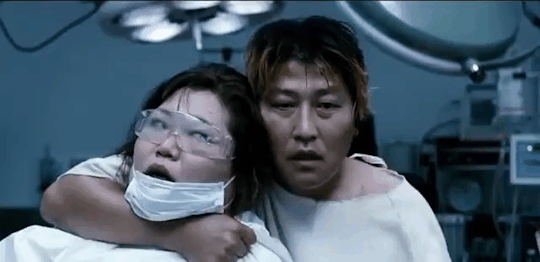
Nam-il wakes up at the same time, not accompanied by a homeless man (Yoon Je-moon), who agrees to take him to the bridge to find Hyun-seo. In the sewer, the two kids have survived, and the creature appears to be asleep. Like a GODDAMN BOSS, she runs up the creatures back, and jumps onto a rope that she had made, and that was hanging far out of her reach. Unfortunately...the creature catches her with its tail. Fuck. It sets her down, and...lets her go? But as soon as she runs, it attacks bother her and Se-joo.
Just then, Gang-du gets to the lair, and uses the rope to climb down. Below him is a pile of bones, and no kids to be seen. The creature goes by, and Hyun-seo’s hand is dangling out of its mouth. And once again by coincidence, that’s when Nam-joo wakes up and reunites with her brother. The creature runs to the waterfront, only to be greeted by...a crowd? They’re gathered there to protest the release of the dangerous chemical into the river.
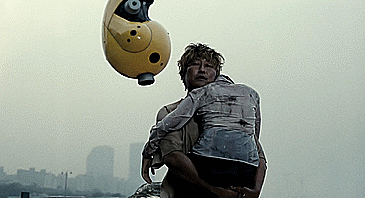
It all collides at once. The creature swims towards the crowd, Gang-du runs towards the creature, Agent Yellow is released over them both, causing the creature to faint. Gan-du runs up and grabs the bodies of his daughter and See-joo from its mouth, apparently too fucking late. Shit, man. This would’ve been avoided if they just HELPED him. Fuck. He carries her body away as more chemical is released onto the flailing creature, and the chemical causes everyone else in the area to violently hemorrhage as well. Meanwhile, Nam-il and Nam-joo arrive to see their deceased niece, grieving all over again. It’s...fuck, man, it sucks.

And Gang-du is fucking PISSED NOW. He grabs a street sign and attacks the injured creature, fueled by pure rage. Nam-il joins in with Molotov cocktails as it runs away. The homeless man douses it with gasoline, and that makes it easier for Nam-il to set it on fire...until he drops the bottle. And then, Nam-joo uses it to light an arrow on fire, hitting the creature with it, and setting it ablaze. It runs to the water, only for Gang-du to stab it through the head with the street sign, finally killing it in revenge for his father and his daughter. Fucking bad-ASS. And also quite tragic, given the circumstances.
And despite the tragedy, there is one happy circumstance: Se-joo lives! In fact, Hyun-seo died saving his life, like the real goddamn hero of this story that she is. Fuck. That’s terrible, but I’m happy that her sacrifice wasn’t in vain. From here, we fast-forward to the winter, where a clean-shaven and well-kept Gang-du is is now caring for Se-joo. The news is on in the background, but the two ignore it, happily eating together after the ordeal they’ve been through.
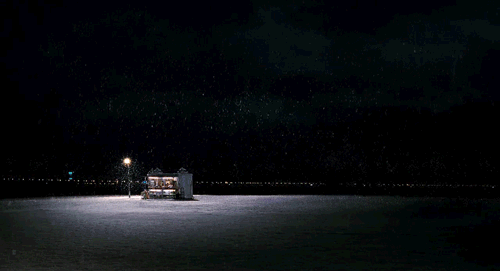
Whoof. That’s The Host, or Gwoemul! And yeah, that’s one hell of a movie, I tell you what. For a monster movie, it’s quite dramatic, and they don’t try to humanize the monster AT ALL. And honestly, I really like it! A Pyrrhic victory at the end, but nothing wrong with that! I’ll elaorate a bit in the review! See you there!
#the host 2005#bong joon-ho#song kang-ho#byun hee-bong#park hae-il#bae doona#go ah-sung#gwoemul#괴물#science fiction may#sci-fi may#user365#365 movie challenge#365 movies 365 days#365 Days 365 Movies#365 movies a year#korean cinema
11 notes
·
View notes
Note
I just realized where we are rn in HxH is about Aug 2001. So now I am wondering if Togashi will have a special event corralating to 9/11 and I'm worried.
let me preface this response by saying I’ve been in research paper spiral for the last four months due to my impending advancement in june, and your question provoked a knee-jerk reaction that led to a 4h-long research spiral by someone whose specialty is absolutely not japanese foreign policy and nationalism.
the tl;dr version here, and then the explanation for it under the cut: I don’t think that’s going to happen. for one, they’re currently on a boat headed to Big Murderous Landmass (unless kurapika and co sink the whale). they’re not in yorknew/nyc. also, japan’s perceptions of 9/11 and the media representations of it are not as pervasive as american or even broader western collective trauma. while togashi is unafraid to address contemporary social politics, I don’t think he’s going to correlate a particular event to 9/11. he’s more concerned with the failings and strengths of humanity, as a whole or in parts, and might reference particular events to get across a greater point, not draw direct parallels.
now, a cut, and then several hundred words on 9/11 as a moment of collective trauma, japanese militarism, and media perceptions. it is 4000% nerdier than this ask expected.
I don’t think togashi is going to include a 9/11 parallel in a large part because of how japanese media, and anime in particular, addresses japanese communal trauma, and how togashi uses moments and evocations of these in his stories (at least, yyh, and hxh, although level e has its own quirks). namely that japan really doesn’t deal with 9/11 like americans do–but they absolutely have other traumas that make their way into anime, manga, and other media.
the thing is that, while 9/11 is absolutely a moment of international trauma (I work in india, and people there are highly conscious of it), the moment that hit the US was very different in other parts of the world. I’m old enough to remember the whole “where were you on 9/11,” itself a sort of marker of solidarity and belonging within the trauma that kind of unites people around a time. the plane crashes were broadcast everywhere in the US, and no one didn’t see it. but we got it live, fed right to the tvs in our classrooms at 8am. and america didn’t get attacked by foreigners before, not like this–problems existed “out there,” not in nyc, for however many times it’s been destroyed on film. (we have our own homegrown terrorists, but that’s a whole other can of worms.) and when it did happen, the country as a whole kicked into a jingoist gear on top of the collective trauma of someone murdering a bunch of americans. freedom fries. they were a thing.
it’s probably important to note here that media doesn’t exist in a vacuum. we’re perpetually influenced by things that happen, whether they’re collective and historical memories, personal experience, or social trends. we get our references and jokes from somewhere, and they sink into our brains and affect what we put out into the world. trauma does this more effectively than most things. trauma elicits a search for meaning, whether it’s a question of “why did it happen” or “why did it happen to me/us?” sometimes we find a meaning in the disaster, and sometimes we don’t. but it marks us and connects us (Halbswach 1992, Updegraff et al 2009). and it affects us for a long, long time.
in japan (and again, I’m not an expert on this), 9/11 is a moment of international trauma that marks japan’s re-entering into the international military sphere, but also economic flux. of the approximately 3000 people killed in the twin towers attack, 316 were non-american, including 26 japanese nationals. japan joined the war coalition almost immediately, and spent billions of USD to support the “war on terror,” while also dealing with things like shohei koda’s beheading in 2004 or the kidnapping and release of 5 journalists and anti-war NGO workers the same year, which arrived back in japan only to be ostracized for “causing trouble” for japan, with accusations that they had “got what [they] deserved” (x, x). the effect on the news media in japan was of increasing conspiracy theories and warmongering, while simultaneously wary of tensions with china, north korea, and taiwan. basically, japan politically and militarily had a lot of pots on the fire, and was feeding yen to the american pot real fast. the japanese SDF pulled out of central asia in 2007, and it’s still a divisive subject from the papers I read, but it’s more about the military than 9/11. 9/11 is not, for example, the topic of a j-drama directly or indirectly. shohei imamura’s short film “japan” in the september 11 (2002) anthology is a parable set during world war ii, although he’s much more famous for his palme d’or wins and a film about hiroshima (black rain, 1989). and uh. apparently pokemon black and white has a reference to ground zero in their map of not!nyc?
japanese media’s collective trauma in anime is often the deep personal connection with the atomic bomb, or terror attacks and natural disasters on japanese soil. which makes sense: humans will generally latch onto things that affect us personally, whether it’s a cute puppy video shown to us or an act of terrorism we watch on television. for the US, we were–and still are–being forced to confront our place in the international community (hero, victim, villain, collaborator, all of it–and americans are not very good at shades of gray) through the “war on terror,” and it comes out in everything from comic book movies like bvs directly evoking 9/11 while cavill!supes ruins buildings to kill zod, to the rise of partisan tv news. but we don’t evoke nuclear war or radioactive waste with the same reaction that japan does–there’s a lot of fear of the bomb in the 1950s and 1960s, like with dr. strangelove and them!, but it’s centered less around the impact of the bomb and its literal or metaphorical nuclear fallout, and more on the fear of the other or an outsider destroying good ol’ american culture. or giving us superpowers. (personally, the closest I think american art and literature ever got to japanese sentiments is with a canticle for leibowitz, which focuses on the cyclical nature of human failure and how the past becomes changed through the present.)
(please read a canticle for leibowitz, it changed my life and only grows more potent with age.)
for japan, the dropping of atomic bombs on nagasaki and hiroshima provides a similar and long-lasting moment of national trauma that’s been preserved in public policy and popular culture. and it’s not just grave of the fireflies or barefoot gen, anime that address the bombings through direct reference. the bomb transforms into concerns about nuclear destruction and environmental fallout, with kaiju like godzilla rising from nuclear waste. osamu tezuka’s work like astro boy is in direct response to the abuse and use of technology and hope for humanity’s future, and naussica of the valley of the wind is a fantasy post-nuclear bomb situation blended with hayao miyazaki’s love of humanity and nature (x, x). I think it’s worth noting that both tezuka and miyazaki personally experienced the 1945 bombings. miyazaki was 4, and one of his earliest memories is fleeing utsunomiya’s bombings. tezuka, at 16 and working in arsenal factories during the fire bombing of osaka, later wrote kami no toride (1977) about his personal experience, which served as both autobiography and condemnation of the vietnam war.
of more recent stuff evoking trauma, naoki urasawa actually uses 9/11 as a moment in billy bat, as part of getting to questions of humanity and modernity and technology and progress. other anime dealing with terrorism, like GITS:SAC, the “brain scratch” episode of cowboy bebop, and of course urasawa’s 20th century boys, locate terrorism not through 9/11 (and the underlying racism and not-us-ness) but more often with these japanese cults like the ‘aum death cult that carried out the 1995 tokyo subway sarin attacks, and the changing landscape of terrorism in japan. we could point to shinichiro watanabe’s zankyou no terror (or terror in resonance? iunno) as a potential 9/11 parallel, and I think it’s got the 9/11 connections, but watanabe himself places it closer to the 1995 terrorist attacks. he even commented how much “darker” zankyou no terror is than the film he was influenced by (the man who stole the sun (1979)), directly citing the 1995 attacks as one reason the last 30 years have impacted japanese understandings of terrorism. more recently, there’s also been connections to the 3/11 disaster with kimi no na wa, where shinkai explores his perennial theme of personal connection across space and time via a form of natural disaster. outside of anime, there’s also a growing body of literature on 3/11 and music, which is super interesting and well worth a look if you’re interested.
fwiw, I think it’s interesting that both urasawa and watanabe are explicitly interested in western and specifically american culture, but through a japanese lens. and not the sort of “japanese lens” that leads to the americas of g gundam or yugioh, which are The Most American Ever, but a more nuanced representation that explores technology, human connection, and modernity. which is the sort of lens creators should try to do when engaging other cultures, at bare minimum. (/soapbox)
trauma isn’t often addressed directly, but allegorically or displaced: lindsay ellis has a great pair of loose canon episodes on 9/11 and how film evokes collective trauma. while she doesn’t talk about anime or japanese films, she uses bollywood as a way to talk about indirect expressions of nationalist trauma. in the second video, she suggests that, for countries like india working through their own terror attacks with mumbai in 2008 (the 26/11 attacks), it’s easier to use other countries’ or places’ or–I would suggest–fantastical trauma rather than directly address it. so bollywood used 9/11 to understand its own trauma. not everyone does this–and a lot of times, I doubt it’s done purposefully, at least initially. but it’s there implicitly, informing decisions of artists and content creators that sometimes doesn’t get revealed until placed under a critical eye. it’s why editing and getting outside or sensitivity readers is important! for japan, the parallels aren’t to other countries, but fantastical situations in japan with Very Heavy Symbolism ranging from akira’s totally-not-a-bombs to kimi no na wa’s processing of the 3/11 disaster via comet.
as for togashi, he uses world events and figures as ways of exploring his own interests (yu yu hakusho has multiple “wow capitalism suuuuuuuuucks” subplots with yukina’s arc and the dark tournament, plus the very anti-war/anti-hate/anti-capitalism/”humanity sucks but people [kuwabara] can be amazing” sentiments of the chapter black tape; while hxh’s chimera ant arc has both a-bomb parallels and north korea/china references on top of killua’s soapbox about how corrupt and terrible governments can be). the parallel between “humanity sucks” and “people can be so very good” threads throughout togashi’s work. but it also uses a very buddhist understanding of rebirth and reincarnation to get these points across, whether it’s the unconditional vore love of pouf and youpi giving themselves to rejuvenate mereum after he’s nuked or the reincarnations of former humans as ants. but all of it connects to togashi’s personal experiences of things happening to and by japan, whether it’s the invasion of and tension with taiwan, the boom and bust of the economy, or the militaristic push by parts of the government under koizumi and abe. that, layered on top of the trauma that informs a lot of japanese media, makes for a fascinating playground togashi is more than willing to dig into.
I suppose this is all a very, very long-winded way of saying that while it’s possible togashi could include a 9/11 parallel, I don’t think it’ll be tied to some september 2001 date in the hxh universe. if he uses it, it will be 1: through a togashi/japanese lens; 2: unattached to a particular date; 3: layered in dialogue with broader war and terror issues togashi’s interested in exploring.
if you’ve made it to the bottom: holy crap congrats, hello, talk to me about anthropology of media. and if you’re somehow still interested in more, here’s an brief list of sources I used on top of the ones explicitly referenced in the post:
Baffelli, Erica. “Media and religion in Japan: the Aum affair as a turning point.” Working paper, EASA. 2008. (media-anthropology.net)
Broderick, Mick (ed.). Hibakusha Cinema: Hiroshima, Nagasaki, and the Nuclear Image in Japanese Film. Routledge and Kegan Paul International, 2014. (google books)
Deamer, David. Deleuze, Japanese Cinema, and the Atom Bomb: The Spectre of Impossibility. Bloomsbury Publishing, 2014. (google books link)
Japan pulls troops from Afghanistan (npr, 2007)
Japan ends ban on military self-defense (time, 2014)
Japan’s 10 years since 9/11 (al-jazeera, 2011)
Krystian Woznicki (September 1991). “Towards a cartography of Japanese anime – Anno Hideaki’s Evangelion Interview with Azuma Hiroki”. BLIMP Filmmagazine. Tokuma Shoten. (archived here)
manga responses to 3/11 (nippon.com, 2012)
Saft, Scott, & Yumiko Ohara. “The media and the pursuit of militarism in Japan: Newspaper editorials in the aftermath of 9/11.” Critical Discourse Studies, 3(01), 2006. 81-101
#hxh meta#japanese history#nuclear memory#symbolism#I'm so sorry#japanese media#9/11#26/11#3/11#all of the references#THIS is what I do for fun#...#sigh#long post#talk tag#Anonymous
33 notes
·
View notes
Text
The Falcon and the Winter Soldier Episode 3: Marvel and MCU Easter Eggs Guide
https://ift.tt/eA8V8J
This article contains The Falcon and the Winter Soldier spoilers and potential spoilers for the wider MCU.
The Falcon and the Winter Soldier episode 3 might end up being remembered as the turning point of the series. A slow burn first episode led to some bigger revelations in the second one, but the third episode of the Marvel series is a bona fide sequel to one of the biggest MCU movies of all time in Captain America: Civil War. With a truly triumphant return for Sharon Carter and the re-introduction of Baron Helmut Zemo in a form that should feel much more recognizable to fans of the comics, there’s plenty of Marvel action to be had in “The Power Broker.”
Here’s what we found…
Dr. Wilfred Nagel
Wilfred Nagel was first introduced in Truth: Red, White, and Black, the same story that introduced Isaiah Bradley to Marvel Comics canon. The comics version of Nagel worked on the super soldier project back in World War II. After Professor Abraham Erksine’s death, Nagel was the one in charge of trying to recreate the process. He was the monster who killed hundreds of Black soldiers until succeeding by turning Isaiah Bradley into a super soldier.
And while Nagel’s comics super soldier program is designed to evoke the horrors of the Tuskegee Experiments, his description of his research in The Falcon and the Winter Soldier sounds more like a different injustice perpetrated on a Black subject: Henrietta Lacks.
Nagel describes working from “blood samples from a semi-stable test subject.” Henrietta Lacks was a young Black mother treated for cervical cancer in the early 1950s. The cancer proved fatal, but a collection of her cells sent to a tissue lab were remarkably hale, growing in the lab where other tissue samples would die out within 24 hours. The cell line cultivated from that sample would go on to be mass produced and used for a ton of biomedical research, even playing a critical role in the discovery of the polio vaccine.
Of course, all this was done without hers or her family’s consent. They didn’t even find out the cell line existed until 1975. That has led to a fight by her descendants and medical ethicists to give her the recognition she deserves for the part she’s played in helping human society, a movement that has only really taken off in the last decade.
Captain America: Civil War
Falcon is annoyed that Bucky won’t move his seat up. Their roles were switched during Captain America: Civil War.
Of course, that’s the only reference to Captain America: Civil War this episode. Just kidding!
Baron Zemo
This is the first time we see Zemo wearing his trademark purple mask. In the comics, Helmut Zemo was horribly burned by adhesives during a fight with Captain America and would hide his mutilated face with that mask.
When Bucky first enters Zemo’s cell, there is a reprise of Henry Jackman’s Captain America: Civil War score. Zemo was the central villain of Cap’s third MCU instalment, and Jackman returned to compose the Falcon and the Winter Soldier score for Marvel.
The Russian code words Zemo immediately uses – “longing, rusted, seventeen, daybreak, furnace, nine, benign, homecoming, one, freight car” – no longer activate the Winter Soldier, but Zemo attempts to press Bucky’s psychological buttons throughout the episode in other ways, and also tries to sow doubt in Sam’s mind about just how “healed” Bucky is from his time as HYDRA’s deadly assassin.
Zemo reveals he is currently reading the works of influential Italian Renaissance diplomat, philosopher and writer Niccolò Machiavelli. This is spectacularly on the nose, as Zemo is just about the most Machiavellian Marvel Comics villain there is – known to use his powers of deception and treachery to play all sides in almost any equation.
Wait, Marvel just dropped the entire “Zemo is royalty” backstory in there like it was nothing! The Baron has officially joined the MCU – with all that entails.
Zemo says that Sokovia has been gobbled up by neighboring states after the Avengers’ battle in Avengers: Age of Ultron left its city in rubble. He rhetorically asks whether Bucky and Sam have been to the memorial, and naturally they haven’t. We’ve seen a glimpse of Helmut standing in front of a memorial statue in trailers for The Falcon and the Winter Soldier, so he may go and pay his own respects at some point.
We also see that some time spent in the slammer has done nothing to change Zemo’s mind on the legacy of superheroes and super soldiers. He still believes they must be wiped out, and murders Nagel in a heartbeat when he thinks he has a chance to end the Super Serum line. Make no mistake, Bucky has a target on his back a mile wide where Zemo is concerned, and we don’t think Zemo will hesitate to kill Bucky as soon as the time is right.
Bucky as Captain America
This is the first time Bucky has suggested that he wield the shield. Not only has this happened in the comics for a time (with Zemo being part of his downfall), but previous Captain America movies have planted the seeds by regularly having Bucky wield the shield in the heat of battle.
So Bucky doesn’t just have a notebook like Steve’s, it IS Steve’s. Wonder if Zemo saw his own name in there?
Sharon Carter
The Sharon Carter we catch up with in episode 3 is much, MUCH closer to her Marvel Comics counterpart – in that she’s badass af – but this Sharon is also extremely jaded after going on the run, and is clearly involved in some other murky business that us viewers are being kept in the dark about, for now.
This is the first episode of The Falcon and the Winter Soldier written by John Wick franchise creator Derek Kolstad, and Sharon Carter becomes the MCU’s version of Wick. Just when she thought she was out, they pull her back in, and she has the unenviable job of fighting a series of Madripoor’s most eager assassins single handedly.
The Power Broker
In case there’s any doubt who holds a lot of influence in Madripoor’s Low Town, there’s some prominent graffiti that promises “The Power Broker is Watching”.
The Power Broker wants that Super Soldier Serum pretty bad, and with Nagel now dead thanks to Zemo, Karli Morgenthau is suddenly holding a lot of bargaining chips.
Any guesses on who the Power Broker might be? There are still three blank slots during the end credits. One of them is surely for whoever is playing the Power Broker. Who could the other two be for?
John Walker
We don’t spend a ton of time with John Walker in this episode, but we see the character’s harder edge increasingly creeping through. His “DO YOU KNOW WHO I AM” feels very much like how the character used to behave during his early post-Captain America days as the U.S. Agent in the comics. John has a bit more nuance here on the screen than he did in the comics, but they clearly aren’t going to shy away from this aspect of the character.
Madripoor
Madripoor is one of the most famous fictional locations in all of Marvel Comics history, first appearing back in New Mutants #32 in 1985. It has pretty much always been primarily associated with the X-Men throughout its history (especially Wolverine, who liked to use Madripoor as his favorite personal vacation spot), but plenty of other Marvel heroes have found trouble in Madripoor through the years (including both the Clint Barton and Kate Bishop versions of Hawkeye, so don’t be surprised if we return here during their series). Of course, there are still no firm plans about how mutants will eventually be introduced into the MCU, this would be a fine place to start looking for clues.
The monkey sign was probably the entrance to the Brass/Bronze Monkey Saloon, a bar we visited back in the very influential Gruenwald Captain America run. Crossbones took Cap’s kidnapped girlfriend, Diamondback, there as he was running from the hero.
When talking about Madripoor, Falcon compares its ominous description to Skull Island, home to King Kong. Funny to drop that reference on the week of Godzilla vs. Kong‘s release. Unless this is referencing a totally different Skull Island. Did the Red Skull have his own island in the MCU?
The Princess Bar
If you’re looking for any big X-Men mutant clues, you should probably start with The Princess Bar itself, which in the comics is owned by Wolverine. But other than that, we didn’t get much in the way of mutant stuff out of these scenes.
Introduced in Chris Claremont and John Buscema’s story in 1988’s Marvel Comics Presents #1, The Princess Bar is owned by a man named O’Donnell and home to a bunch of Wolverine espionage shenanigans. At some point, Wolverine bought a silent partnership in the bar under his Madripoori alias Patch (Wolverine in a white tux with a patch over one eye, in the worst cover identity since that time Zooey Deschanel got rid of her bangs). These days in the comics it’s owned by Krakoa generally, as Captain Kate Pryde and her crew of Marauders are putting in quite a bit of work in Madripoor.
Snap Wilson
Falcon is annoyed because his Madripoor outfit makes him look like “a pimp.” For a time, Marvel retconned it so that when Steve Rogers met Sam Wilson originally, he was actually a pimp named Snap Wilson. Some time later, Marvel decided that this was in bad taste and undid the retcon. It has since been explained away as Red Skull trying to alter time and space with the Cosmic Cube, as he has been known to do.
Anyway, Sam’s “pimp” outfit is because he’s supposed to be masquerading as…
Smiling Tiger (Conrad Mack)
Smiling Tiger (Conrad Mack) is an archnemesis of the New Warriors who has, for a time, helped run the criminal underworld of Madripoor. Fittingly, while people may see Madripoor as the first step in seeing Wolverine show up in the MCU, Smiling Tiger’s comic incarnation has a noticeable resemblance to the famed X-Men member.
Trouble Man
cnx.cmd.push(function() { cnx({ playerId: "106e33c0-3911-473c-b599-b1426db57530", }).render("0270c398a82f44f49c23c16122516796"); });
Sam once again brings up Marvin Gaye’s Trouble Man soundtrack album, which he has been talking about literally from his first minutes onscreen in the MCU. He’s right, by the way, this album rules. Funny enough, this episode airs on April 2, which would have been Marvin’s 82nd birthday. Go listen to this album specifically or Marvin in general in honor of the man.
Black Panther
Bucky follows a trail of tech breadcrumbs at the end of the episode after previously warning Sam that Wakanda hasn’t forgotten the killing of King T’Chaka during an attack orchestrated by Zemo in Captain America: Civil War. Waiting for him in a quiet side street is Ayo (Florence Kasumba) second-in-command of the Dora Milaje from Black Panther, who is less than happy about Zemo’s freedom. We wrote more about what this is gonna mean for Sam, Bucky, and Zemo here.
The post The Falcon and the Winter Soldier Episode 3: Marvel and MCU Easter Eggs Guide appeared first on Den of Geek.
from Den of Geek https://ift.tt/3mezxhQ
0 notes
Text
Kamen Rider 45th Anniversary File: Shotaro Ishinomori

1938:
Superman debuts in Action Comics #1
Walt Disney establishes himself as a leading pioneer of animation with the first full-length feature film Snow White and the Seven Dwarfs.
King Kong Appears in Edo, a jidaigeki take on America’s 1933 King Kong film debuts and is one of the first kaiju/tokusatsu films in history. It is sadly also a lost film as all prints are believed to have been lost or destroyed during the war. The only evidence of its existence are old movie posters, some production photos and archived magazines.
Eiji Tsuburaya briefly works at the Tokyo branch of Toho Studios as head of the Special Visual Effects department, but later leaves and works on war propaganda films for the Japanese government.
Hitler assumed absolute power over Germany by overthrowing the established government. World War II is fast approaching as this evil man spread his philosophies of death, chaos and madness.
The Great Depression hits even harder after almost a decade around the world and would not let up until 1941 and officially end by the late 40s and early 1950s. (though a recession would hit in ‘58)
Japan was at war with China.
And while the world braced for more doom, death and gloom and seeing the absolute worst in humanity....
On January 25th, 1938, Kashiku Onodera and Kotaro Onodera welcomed the newest member of thier family: their second oldest child Shotaro. The Onodera family would later consist of five brothers and an older sister named Yoshie.
Young Shotaro grew up during the second World War and by middle school would be something of a curious artist. He would make manga of his own and his first one published was in 1954 with Second Class Angel. This hobby eventually paid off in 1955 when he got an assistant job from...
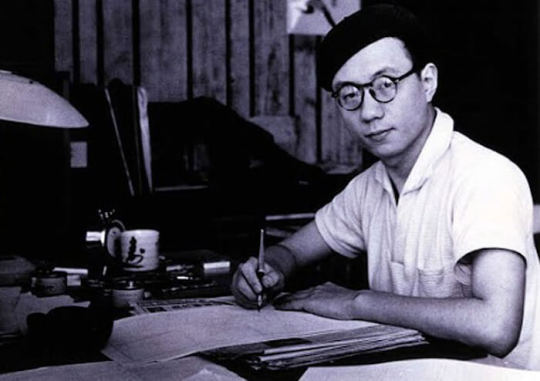
Osamu Tezuka!
His tasks were to help the cartoonist on various manga, most notably a story in Tetsuwan Atom aka Astro Boy.
When not working with Tezuka, Ishinomori would do his own manga adapting classic literary works. Some of the novels would later inspire him for his creations, such as Akumaizer 3, his own wild spin on the Three Musketeers.
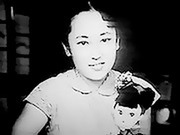
While he was a good artist, his family was less than supportive of his work aside from his big sister Yoshie. She was always there for her little brother and cheered him on, even inspiring him to draw. She even visited him while he worked in the Tokiwa-so building in Tokyo and hung out with his fellow artists. Which is all the more tragic, as she died in 1958 from complications of asthma at only 23 years of age.
This tragedy and the inability to do anything to save her life haunted Ishinomori and some of his female characters are loosely based on the kind of person she was or had bits of her character traits. So in essence, the Pink Rangers, at least in spirit, just may possibly have a part of her that resides in the heroines of Sentai and indirectly; the Morphin’ Grid. Female heroes such as Tackle (whose actress also sadly died of an asthma attack) also could be influenced by the kind of personality she had when she was alive.
On July 19, 1964, Shotaro created Cyborg 009, which launched him into super stardom.
On April 3rd, 1971, he hit the big time by teaming up with Tohru Hirayama to create Kamen Rider.
From there, he became synonymous with Super Heroes. But Ishinomori was a jack of all trades, he also did dramas, love stories, crime stories, Shoujo, ninja etc. So calling him “The Stan Lee of Manga” while somewhat factual in terms of superheroes, is kind of an insult to his prowess as he was more expansive in versatility than that.
Originally going by Ishimori, Shotaro changed it to Ishinomori in 1985 to celebrate 30 years of working in the media industry.
His influence is just as great as Tezuka, among those who worked for him were:
A young animator named Hayao Miyazaki in the 1960s worked as an artist on some of Ishinomori’s animated films.
Go Nagai, a student of his and an assistant. Later became a legend in his own right after leaving him in 1967 to create Mazinger Z, Cutie Honey and most famous of all, Devilman! Go Nagai once appraised in an interview that his mentor had a drawing ability that bordered on being superhuman as “He was a genius who could draw five times faster than the average adult artist.”
Kazuhiko Shimamoto
Takao Aoki, the creator of Beyblade (worked on a short story featuring RX and ZO and on the Kamen Rider ZO TV-Kun manga)
Ishinomori was also a lyrical composer, as some of the songs in Kamen Rider were written by him. Even fan favorite songs of his other works such as Taga Tame Ni from the ‘79 Cyborg 009 anime was written by him.
ForestofStone can explain his life a lot better than I can (Credit to her for some of this interesting info!):
http://forestofstone.tumblr.com/post/125974267909/shotaro-ishinomori-the-king-of-manga
Cameos
Despite being in manga, anime and TV, Ishinomori originally wanted to be a filmmaker and went on trips to see landmarks and observe the world around him for inspiration. This gave him better insight into people and inspired his drawings in some cases.
He even decided to take a page from Alfred Hitchcock and make cameos in his TV shows and films:
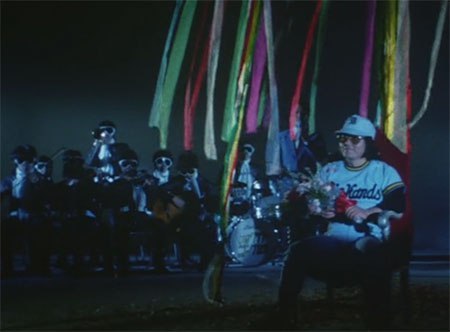
Kaiketsu Zubat Ep. 10: A Baseball player
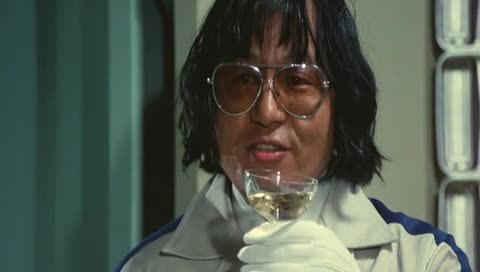
A guest on a luxury cruise in the film Eight Riders vs. Galaxy King.
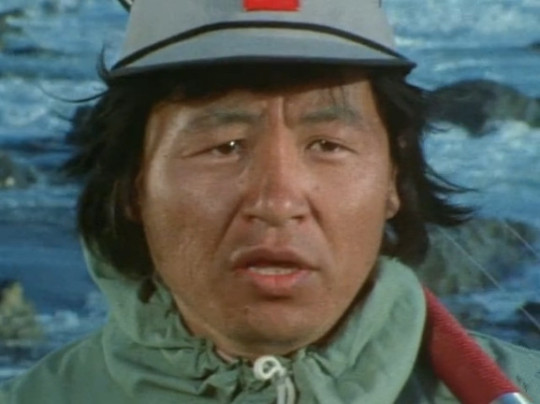
A Fisherman who gets killed by the monster of the week in episode 84 of the original Kamen Rider.
He also cameoed in video games:


A fisherman in the Kamen Rider Black Movie Hurry To Onigashima. Now sporting a ‘stache with his trademark afro.
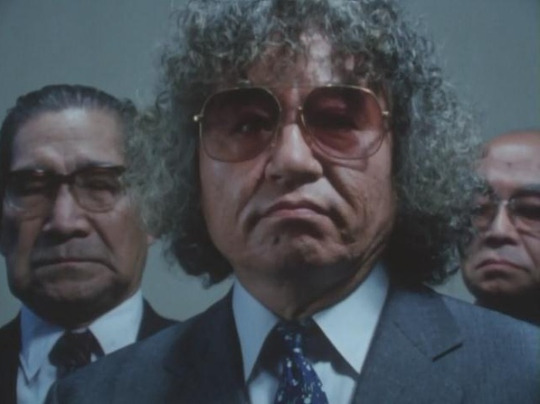
His final living cameo in Shin Kamen Rider Prologue as a spy eavesdropping in on the Foundation.
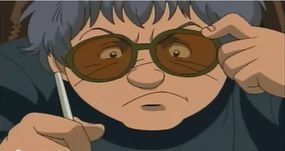
Even after he died, he still is a presence in the works he created. In Cyborg 009: The Cyborg Soldier he appears and interacts with Professor Gilmore (though voiced by someone else).

Shotaro Ishinomori, as drawn by his biggest fan Kazuhiko Shimamoto in a manga.
Of course, all life must end. It is the biological entropy of the universe we can never fully escape as we all must go at some point. And such a creative talent was taken from us far too soon.
But the late Mr. Ishinomori now has two museums made in his honor, a Guinness World Record posthumously awarded for the most comics drawn by a single author, tons of manga artists who view him as a role model and a growing amount of respect from artists in the American comic book industry.
1998:
Seiju Sentai Gingaman debuts
Ultraman Gaia airs, created by future Digimon Tamers head writer Chiaki J. Konaka
Kids around the world were crazy ‘bout the Pokeymans, some of which were inspired by the Kaiju of popular films in design.
Disney celebrates 60 years of making animated films with their latest feature Mulan.
Superman turns 60 and is sporting an electric blue costume (with a cool shield design but lacking his trademark powers).
Power Rangers in Space airs.
Megaranger vs. Carranger hits VHS
Rebirth of Mothra III, the last entry in the Rebirth of Mothra series premieres in Japanese theaters.
Ultraman Tiga & Ultraman Dyna: Warriors of the Star of Light acts as the first Heisei film crossover of Ultras and premieres in Japanese theaters.
America made a Godzilla movie. This was a terrible mistake and made a lot of people angry. It also had that Taco Bell dog promote the film by doing a commercial or two. HEERE LEEZARD LEEZARD LEEZARD!
Often fans wonder what would have happened had he lived into an older age.
Well for starters, Kamen Rider would be vastly different given some of his concepts and that Bijinder movie would have been made. Cyborg 009′s story possibly would have been completed over a decade earlier.
Jerry Robinson of Batman fame would have done a crossover with Kamen Rider, having met Mr. Ishinomori in Japan and proposing such in 1996, with possible further collaborations with DC Comics when they had the manga imprint CMX. Shotaro could have taken advantage of Japanese media coming in droves to the US during the 90s Anime boom to do new projects exclusively for America.
So many possibilities, but none can come to pass. But let’s not focus on the “What if’s”, let’s focus on the man’s legacy and pay our respects.
Here’s to you Mr. Ishinomori, without you there would be no Kamen Rider or Power Rangers. Thank you so much for giving us a wonderful world of characters and stories and I’ll do my best to pass them onto others so they too can tell them to the world! エクセルシオール Ekuserushiōru!
62 notes
·
View notes
Text
It’s time for our weekly Diamond Comics Shipping List! Check out some great titles IDW has in store for us next week like Transformers, Transformers/Ghostbusters, G.I. Joe: A Real American Hero, Godzilla: Kingdom of Monsters, Usagi Yojimbo, and more! All coming your way for July 17th!
TRANSFORMERS #9
Brian Ruckley (A) Cachet Whitman, Bethany McGuire-Smith (CVR A) Umi Miyao (CVR B) Priscilla Tramontano
Time is running out! Orion Pax, his friends, and the Autobot security forces have to get a grip on their murder investigations as their superior, Sentinel Prime, makes his return to Cybertron! Secrets are revealed as loyalties shift! Sentinel Prime and his diplomatic entourage return!
TRANSFORMERS/GHOSTBUSTERS #2
Erik Burnham (A/CVR A) Dan Schoening (CVR B) Priscilla Tramontano
“GHOSTS OF CYBERTRON” Part 2! Okay. So. It seems as though there are giant robots who can disguise themselves as vehicles out there in the universe, and, as it happens, one of them as taken the place of Ecto-1. When the Ghostbusters discover this replacement, they naturally have a lot of questions-and this time, even the boys in gray might not believe the answers!
TRANSFORMERS #1 3RD PTG
Brian Ruckley (A) Angel Hernandez, Cachet Whitman (CVR) Gabriel Rodriguez
TRANSFORMERS #3 2ND PTG
Brian Ruckley (A) Angel Hernandez, Cachet Whitman (CVR) Nick Roche
TRANSFORMERS #4 2ND PTG
Brian Ruckley (A) Angel Hernandez, Andrew Griffith (A/CVR) Sara Pitre-Durocher
GI JOE A REAL AMERICAN HERO #264
Larry Hama (A/CVR A) Netho Diaz (CVR B) Dan Fraga
G.I. Joe battles for justice, liberty, and freedom around the globe, and with the evil terrorist organization known as Cobra slithering around every corner, the stakes have never been higher! Living Legend Larry Hama and superstar artist Netho Diaz continue the latest explosive arc of… G.I. Joe: A Real American Hero! The first of two connecting B covers by artist Dan Fraga!
AMBER BLAKE #4 2ND PTG
Jade Lagard?re (A/CVR) Butch Guice
BRAM STOKER’S DRACULA TP
Roy Thomas (A) John Nyberg (A/CVR) Mike Mignola
Advance solicited for July release! The comics adaptation based on the film from Columbia Pictures (Sony) and Zoetrope Studios returns with all-new colors. Mike Mignola is one of the most popular comic book artists of the past thirty years, known for such important works as Batman: Gotham by Gaslight, Cosmic Odyssey, and, of course, Hellboy. Considered to be among Mignola’s greatest works, Bram Stoker’s Dracula was his last project before Hellboy launched and was originally released as a full-color four issue adaptation of Francis Ford Coppola’s 1992 movie. Updated with all-new colors! New cover by Mignola!
FOR BETTER OR FOR WORSE COMP LIBRARY HC VOL 03
Lynn Johnston (A/CVR) Lynn Johnston
No phone, no light, no motor car, not a single luxury-John and Phil’s canoe trip turns them into castaways on an island! Once back in civilization, John solves his mid-life crisis by buying a sportscar, and Elly improbably winds up in front of a judge as a result! Michael enters junior high school, but not before learning a different sort of life lesson at summer camp with a girl named Martha, while Liz loses her first tooth, gets her ears pierced, and finds herself in a “Mean Girls” situation with her friends at school. Then it’s wedding bells for Uncle Phil, and Lawrence moves back to town-with a new family of his own! Volume Three, which collects the complete daily and Sunday comics from July 6, 1986 through December 9, 1989, brings to a close the first decade of Lynn Johnston’s modern masterwork, but of course, the story is just getting started…
• Advance solicited for April release! • “An exquisite tome… Fans of the highest virtuosity in cartooning will relish this deluxe introduction to the Patterson’s heartfelt and delightful story”-Library Journal • The beloved newspaper comic strip that chronicled the saga of the Patterson family in real time, over three decades, continues in this, the definitive edition.
FROM HELL MASTER EDITION #6
Alan Moore (A/CA) Eddie Campbell
“From Hell.” The narrative makes room for such figures as Aleister Crowley and William Butler Yeats while the killer writes the note which gives our work its title. Five unsolved murders. Two of the greatest creators in the history of comics. One sprawling conspiracy, one metropolis on the brink of the 20th century, and one bloody-minded Ripper ushering London into the modern age of terror. The award-winning bestseller FROM HELL, often ranked among the greatest graphic novels of all time, takes on haunting new dimensions in FROM HELL: The Master Edition, enhanced with impressionistic hues by Eddie Campbell himself. This volume contains Chapter 9, as well as all the original annotations.
GHOST TREE #4
Bobby Curnow (A/CVR A) Simon Gane
Mysteries are solved as an ancient evil rises. Will Brandt and his family be able to come to terms with their actions before the present is ruined? What does the future hold for those trapped in the past? The heartfelt conclusion to a most unusual tale!
GODZILLA KINGDOM OF MONSTERS TP
Eric Powell, Tracy Marsh, Jason Ciaramella (A) Phil Hester, Victor Santos, Bruce McCorkindale (CVR) Eric Powell
Advance solicited for July release! The King of the Monsters rises again, and he’s bringing lots of other beloved Toho monsters with him in one destructive saga! When Godzilla appears off the coast of Japan, the Japanese government must respond quickly to contain the disaster… but before long, other monsters begin appearing all over the world. Can humanity survive this mysterious onslaught of giant beasts? Featuring Anguirus, Battra, Destroyah, Gigan, Hedorah, King Ghidorah, Kumonga, Mechagodzilla, Mothra, Rodan, Spacegodzilla, and Titanosaurus. Collects the entire 12-issue series for the first time.
LEAGUE OF EXTRAORDINARY GENTLEMEN: TEMPEST #6
Alan Moore (A/CVR) Kevin O’Neill
In Moore and O’Neill’s final comic book, this issue masquerading as a British science-fiction weekly, the plot-strands of our concluding volume and loose ends from twenty years of continuity are tied in an ingenious starry bow, as Mina Murray and her legendary confederates transition from the world of fiction past and present to the world of fiction future. Planets end in visual spectacle, lovers are united in the matrimonial event of the millennium, and deadly enemies draw close in the conclusion of their fatal dances. This is your last call for the immaculate crescendo of The League of Extraordinary Gentlemen, Vol. IV, The Tempest.
MARVEL ACTION CLASSICS CAPTAIN AMERICA
Scott Gray, Roger Langridge (A) Craig Russeau, Matteo Lolli (CVR) Clayton Henry
Four tales for the price of one! Captain America, living legend of World War II, battles spies in Hollywood and M.O.D.O.K.’s predecessor P.R.O.D.O.K…. but nothing prepares him for spending the next few decades frozen in ice! When he comes to in the present day, Hydra strikes and Cap learns the action hasn’t let up-the Marvel Action, that is!
• Classic Captain America tales from the legendary vault of heroes! • All-ages action in the past and present! • Reprints Marvel Adventures Super Heroes #8 and #12!
RAGNAROK BREAKING OF HELHEIM #1
Walter Simonson (A/CVR A) Walter Simonson
In the end, the gods gathered together and met their foes on the Battle Plain of Vigrid. There, so the stories tell, the gods and their great enemies slaughtered each other, the stars fell from the sky, Midgard itself sank into the all-encompassing ocean, and the Nine worlds were destroyed. In this issue, Thor hears a voice out of the past and learns that not all the old stories are true, and that the path before him now leads to Helheim, the land of the Dead. Walter Simonson, legendary creator of Star Slammers, Manhunter and the Alien film adaptation (with Archie Goodwin), and the definitive version (after Stan and Jack) of Marvel’s Thor, presents the next thrilling chapter of his own post-Ragnarok Thor saga!
RIP KIRBY HC VOL 11 1973-1975
Fred Dickenson (A/CVR) John Prentice
The longest-running modern adventure strip continues with 11 new stories starring the debonair private detective, reproduced from the original King Features Syndicate proofs. In these stories, Rip Kirby takes part in an old-style shoot-out in a nearly deserted Western ghost town, battles the deadly Owl and the Pussycat over a hidden stash of heroin, and rubs a magic lamp the wrong way in a Turkish bazaar. After learning he is the doppelganger of the crown prince of a postage stamp-sized country, the bespectacled detective follows the train of a counterfeit two million before being framed by a paroled con man who wants to get even with Rip for making him play second fiddle in the prison orchestra. Plus-the long-awaited return of Rip’s original girlfriend, Honey Dorian, as well as his arch-nemesis, the deadly Mangler! The more than 800 sequential comics from January 22, 1974 to October 11, 1975 also feature Rip’s new girlfriend, Holly Glowstep, and standbys such as Desmond, Wiggins, and Ma Casino.
• Advance solicited for July release! • “John Prentice’s work is superb. He’s one of the few cartoonists who took an important strip by a great cartoonist and did it not only justice, but in some ways, was as good as-and in some cases better than-the originator.”-Tom De Haven, author of the Derby Dugan trilogy
ROAD OF BONES #3
Rich Douek (A/CVR A) Alex Cormack
There is no god but hunger. And the loss of their food has driven Roman, Grigori, and Sergei to the absolute extreme. Knives are sharpened and souls are searched as each man decides just how far he is willing to go in order to survive the brutal tundra. One thing is certain, though-one must die for the others to live. Escape from the gulag takes a brutal and horrific turn in Road of Bones #3, from writer Rich Douek (Gutter Magic) and artist Alex Cormack (SINK).
SONS OF CHAOS HC GN
Chris Jaymes (A) Alejandro Aragon
Oversized, panoramic graphic novel Sons of Chaos, exposes the quiet agenda of the Ottoman Empire’s most brutal dictator, and his fascination with a young Greek boy that led to a war that would define the Western World.
An immersion into the moments we never see, and the self-serving motivations that convince a nation that violence is warranted, and that war is necessary.
In honor of the 200 Year anniversary of the Greek War for Independence, Sons of Chaos presents the story of 1821 through the eyes of Marcos Botsaris, the son of a respected Greek leader taken prisoner as a child and raised within the dungeons of history’s most infamous Ottoman Pasha, known as the “Napoleon of the East”– Ali Pasha of Ioannina. Over the next ten years, the bond formed between them would define history.
The Greek War for Independence was a conflict that quietly influenced the entire world and participants ranged from the London Stock Exchange to celebrities such as Lord Byron, as well as average impassioned Americans willing to transport themselves across the Atlantic to fight alongside the Greeks.
This conflict was the pinnacle of what we now know as the Romantic Period and yet, it’s a war that few know ever existed outside of the Greek and Turkish cultures; a war that stimulated the fall of the Ottoman Empire and shaped Western Civilization as we now know it, and in a sense is being fought today under a different heading amongst today’s political world leaders.
Hundreds of years of Ottoman rule gave the Greeks a reason to fight. Marcos Botsaris gave them a leader.
THEY CALLED US ENEMY TP
George Takei, Justin Eisinger, Steve Scott (A/CVR) Harmony Becker
Advance solicited for July release! George Takei has captured hearts and minds worldwide with his captivating stage presence and outspoken commitment to equal rights. But long before he braved new frontiers in Star Trek, he woke up as a four-year-old boy to find his own birth country at war with his father’s-and their entire family forced from their home into an uncertain future.
In a stunning graphic memoir, Takei revisits his haunting childhood in American concentration camps, as one of over 100,000 Japanese Americans imprisoned by the U.S. government during World War II. Experience the forces that shaped an American icon-and America itself-in this gripping tale of courage, country, loyalty, and love.
TREASURES RETOLD: THE LOST ART OF ALEX TOTH HC
Alex Toth (A/CVR) Alex Toth
A blockbuster collection of rare and little seen stories and artwork by the legendary Alex Toth. Included are complete stories from the 1950s and beyond, recently discovered color animation storyboards and presentation drawings, sketches and doodles, industrial comics, and individual pages from obscure comics and magazines. It’s a treasure trove that makes a fitting companion to the three-time Eisner Award-winning Alex Toth: Genius trilogy.
Toth’s significance to comics and animation art cannot be overstated. During his career, he was the comics field’s foremost proponent of modern design and composition. His work influenced almost every one of his contemporaries and has continued to work its magic on the generations that followed.
• Advance solicited for March release! • The Alex Toth: Genius trilogy won the Harvey award and three Eisner awards!
USAGI YOJIMBO #2
Stan Sakai (A/CVR) Stan Sakai
“Bunraku,” Part 2. Strange circumstances continue to surround a travelling puppet show as Usagi becomes embroiled in one of his most eerie adventures yet! Will the aid of a supernatural ally be enough for Usagi to prevent more death? Stan Sakai’s long-running epic continues its first thrilling storyline at IDW Publishing! Exciting samurai action, now in color!
Join the IDW Hasbro Shared Universe related conversation here in our Comics Discussion and Reviews section and here for all other franchises, superheroes, or general comic book discussions! Not a member? Join our community by creating your own free account here! Or jump right into the live chat on our Discord server or our Facebook Group!
IDW Comics Shipping List for July 17th! It’s time for our weekly Diamond Comics Shipping List! Check out some great titles IDW has in store for us next week like…
#Bram Stoker&039;s Dracula#Captain America#Comic Book#Comics#Diamond Shipping List#From Hell#G.I. Joe#G.I. Joe: A Real American Hero#Ghost Tree#Ghostbusters#IDW#IDW Publishing#IDW Reboot#IDW2#IDW2 continuity#Marvel Action#Stan Sakai#TF#Transformers#Transformers/Ghostbusters#Transformers/Ghostbusters: Ghosts of Cybertron#Usagi Yojimbo
0 notes
Text
Review Of Kong: Skull Island
As the US military formally withdraws from the Vietnam War in 1973, Will resolute government organization presented as well-known monarch with a golden opportunity - with satellite photos, only die die existence A known unknown location revealed as Skull Iceland, Usually on the die inaccessible to the outside world. With his window of opportunity is closing bald, Monarch employees William Randa (John Goodman) and Houston Brooks (Jason Mitchell) mounted hastily An expedition to the island to discover the mysterious life forms was living there, under the pretext of a study Of basic landscape geology,
With a team that former captain of the SAS expert / prosecutor James Conrad (Tom Hiddleston), photojournalist Mason Weaver (Brie Larson) and Sky Devils helicopter squadron, led by Einem Colonel Preston Packard Contains ( Samuel L. Jackson), die for the Monarch expedition to Skull Iceland Begins. But quickly die immediately on the island to Überraschungen, people are face to face with this Kong: A giant creature like a monkey, they do not penetrate friendly and takes explosives in the home country to fail this to allow strangers. And those who die die first encounter with Kong survive bald, he is not even die most dangerous creature of the skull dies Iceland is ... During the reboot in 2014 Director Godzilla Gareth Edwards mainly as reinterpretation Standalone of the Godzilla myth, director Jordan Vogt-Roberts' Kong Developed: Skull Iceland is a reinvention of the mythology of King Kong Designed to pave a greater chance for Joint of the Universe (MCU And a matrix DCEU) verses of the monster known as cinematic. A glorious "pilot" for Verse Monster Be Skull Iceland is a CLOSER be Einem Independent episode cinematic experience, but only the end of their agreement is to be held when it comes to the entertainment value of a right blockbuster to provide. Kong: Skull is the Iceland Launchpad Divided universe one, the promise of the big, clumsy monster chaos finds its - the creation of even reaching bigger things. (Literally speaking Grosser's path.)
Kong: Icelandic Skull, The story solid turn to the monster version back King Kong, to those films in the future can be built. The team's screenplay for the film Max Borenstein (Godzilla), Derek Connolly (World Jurassic) and Dan Gilroy (Nightcrawlers) and John Gatins (Real Steel) screen RECIEVE credit history, making the classic elements of the enough myths dying of EFFEKTIV's will The "eighth wonder" as the monster verse painting equivalent A dedicated balance superhero in the nature and Ihren region of origin to keep Kong. Skull island attracts themed parallels so clear to display Godzilla, monster king cave the power of nature benign half and his version of the restart King Kong, same seeds die so planting both Monster Battle and both can any team - to ANALYTICA. As Godzilla, Meios dies Also Kong: Iceland Skull prioritizes the development of the world and dying in the development xará player distribution of different human calves. While most dies human characters Kong: Icelandic non-dimensional archetypal skulls develop, benefit from charismatic Einem and talented cast life Will awakened. As with the followers of the movie War, die in the occupation of the main island character skull is like John C. Reilly Hank Marlow, a former second fighter pilot in World War II, dying for decades in dignity in Corfu, ideal captivity To Überraschungen Other characters. The ideal, good, but funny, and Hank A matching movie for other human players more developed film: Lieutenant Colonel Packard, a militars man for life brought to life through a landscape that (in a good way chews) Samuel L, Jackson. Packard insane decline (Fed by his post-Vietnam state of mind) How clearly that not intended is so compelling, but Jackson makes the human opponents is fun and is still a few reporters characteristic reef movie moments (including famous line seiners Another great success of "Monster").
As a sign Packard Kong: Iceland Skull as a whole through the Vietnam War films inspired as Apocalypse Now, if your imagination to create a post-Vietnam version. During this historical context is also this re-imagining of the myths of King Kong, the film is successful in re-creating the palette of colors and aesthetics of the Vietnam war films (they give a modern polish) to channel their spirit; Returning Kong: Iceland Skull, in a superficial imitation of these films, instead of a rich tribute subjects. With that said, Iceland Skull offers a lot in the visually stunning giant monster show and Jungle Adventure, thanks mainly to cinematographer Larry Sharp Photography Fong (Batman Superman: Dawn of Justice). Vogt-Roberts also creates a touch of glamor in the process, remembering his debut in the independent film The Kings of Summer, while he was well-balanced tonal changes from the film and the Icelandic Skull Personality scenarios that could have had. Iceland Skull guarantees a constant and kinetic sensation ride through the run time, but again, it is best to develop your human characters in part, costs. Tom Hiddleston and Oscar winner Brie Larson do a good job in their roles as human co-stars of the film, but the leaves of their characters are quite simple and conventional. The same is with John Goodman and Corey Hawkins as members of the Monarch organization leading the expedition to Iceland Skull true; While your colleagues on the screen also benefit from a position by some actors portrayed by being. Kong: Iceland Skull has a very large support cast to give them all the same amount of time in the limelight, but still sculpt enough space for players like Juan Ortiz (silver book gloves), Tian Jing from (The Great Wall), Thomas Mann Shea Whigham (Carter Agents) and Straight Outta Compton Hawkins co-star Jason Mitchell as members of the Packard unit proved to be the memorable one. Of course, human monsters verses are increasingly aware that their planet is not about them "their" and Kong: Iceland Skull continues this point in the process of a huge rollicking monster adventure provide preparatory stage and battle for the Grander line (particularly during the Post-movie scene-monster). Those who are not fans of the slow burning were approaching Godzilla reboot and the buildup of their monster battles could even Icelandic Skull found to be an antithesis of this, apparently adapted their criticism of Warner Bros and Legendary approach. What the future may have Monster Versus these studies however, there are now firmly established icons of King Kong and Godzilla with specific versions to play in the sandbox.
via Blogger http://ift.tt/2o3ua6X
1 note
·
View note
Photo
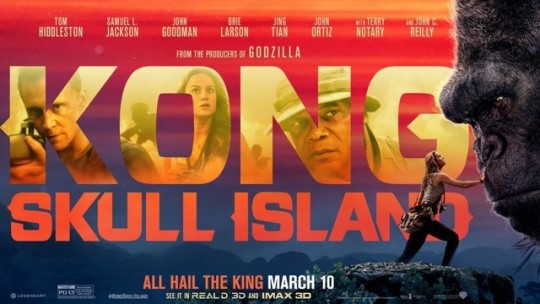
Skull Island' Review: King Kong Kicks Butt In This Gorgeous Pulp Adventure | Forbes
Kong: Skull Island opens in North America on March 10, 2017 courtesy of (among others) Legendary and distributor Warner Bros./Time Warner Inc. The film, budgeted at around $185 million, is both the start of a would-be franchise and something of a backdoor pilot for what the Dream Factory hopes will be a cinematic universe involving the likes of King Kong, Godzilla and other famous beasties. We’re getting Godzilla: King of the Monsters (a sequel to the 2014 Godzilla) in 2019 and Kong vs. Godzilla in 2020. So as you can see, there is more at stake than a single movie.
That’s the inherent risk of this whole expanded universe game. Under normal circumstances, Kong would merely be responsible for making enough money and audience approval to justify its expenses further installments. But since it’s the backbone of an expanded universe, a responsibility that Godzilla did not share, it has the extra burden of justifying and creating excitement for what comes next. Once again, Mr. Kong, we ask too much of you.
The good news is that, should this film do well and get decent reviews, it will go that much further in dispelling the conventional wisdom that Warner Bros. is a house of horrors due to the ups and downs of DC Comics movies. Fantastic Beasts and Where to Find Them earned $811 million worldwide and mostly positive reviews while The LEGO Batman Movie scored raves and solid box office. If the Skull Island is a well-received hit and King Arthur: Legend of the Sword avoids utter embarrassment, there is frankly only so much grief we can give the studio no matter how good or bad Wonder Woman and Justice League turn out to be.
The Review:
Kong: Skull Island is high-quality pulp fiction. The picture is a briskly paced and character-driven adventure that just happens to be a big-budget monster mash and part of a would-be cinematic universe. The film has a game cast amid stunning visuals and gorgeous cinematic sights. It may not be the eighth wonder of the world, but this King Kong revamp is often quite beautiful.
While the film is technically a prequel to the Gareth Edwards’ Godzilla, it stands entirely on its own in terms of content and visual style. The 2014 monster mash was a grim and foreboding affair, shrouded in darkness and mystery while offering the barest hint of humanity amid its jaw-dropping visuals. Skull Island goes almost the opposite route, plunging us immediately into the world of its quirky human characters and wasting little time giving us what we came to see and delivering most of its thrills in broad daylight.
Regarding cinematic foreplay, this is less Jaws and more The Host. While both styles have their merits, Dan Gilroy, Max Borenstein and John Gatins’ witty screenplay keeps us entertained and intrigued during the exposition and earns our investment in those who will soon fight for their lives. While I wouldn’t argue that this is a course correction, as Godzilla (which I didn't care for beyond the visuals) certainly had its merits and its fans, it is encouraging that the second film in this continuity can be so different regarding tone, focus and style. This is a possible signal that Legendary and Warner Bros.’ monster universe might well be filmmaker-driven.
While Godzilla was called “the first post-human blockbuster,” Kong: Skull Island is as much about watching the likes of John Goodman, Tom Hiddleston, Brie Larson and Samuel L. Jackson chew scenery as it is about King Kong and the various monsters of Skull Island. But fear not sports fans, you get a whole heaping of monster mash action throughout the 118 minutes. If you’ve managed to go this far without knowing too much, especially if you’ve avoided the most recent trailer (note: do not watch the final spoiler-filled trailer), I’ll try to be as vague as I can.
Set in 1973 as the Vietnam War winds to a close, the film follows a group of motley outsiders, including a discredited scientists (Goodman), a professional soldier (Hiddleston), a cynical war photographer (Larson), a geologist (Corey Hawkins), a biologist (Jing Tian) and the head of the chopper unit tasked with flying these folks into uncharted peril (Jackson). Goodman and friends are heading to Skull Island to conduct a land survey. Things almost immediately go to hell.
Shot by Larry Fong, the guy who almost had me giving Batman v Superman a positive review, this is an utterly beautiful motion picture. The naturalistic visuals, imbued with a particular hot orange vividness, gives the film an absolute authenticity of time and place and at least the appearance of realism even when we are clearly watching special effects. I saw this in glorious 2D, but I imagine it’s worth the IMAX 3D upgrade as the broad daylight action will probably survive any 3D glasses-related dimness.
And the title creature is a marvel, standing 100 feet tall and exuding animalistic menace no matter which side he’s fighting on at any given moment. His major introductory beat is a superb action sequence, even if it’s structured more for action-adventure thrills than horror or intensity. The film manages to humanize its main monster without being overly patronizing. This Kong is a protector of Skull Island. But if you get into his turf, he will bat you out of the sky without thinking twice.
Even after the monstrous stakes are established, there is still a relative focus on the humans attempting to survive and make it to a planned pick-up spot. Along the way, they stumble onto World War II soldier who has been living on the island for 30 years. Said MIA (John C. Reilly) provides comic relief, a surprising poignancy and plenty of exposition. Reilly quickly becomes Skull Island’s MVP.
Most of the survivors are focused on not dying, while Jackson allows his grief over first act casualties to turn him into a Captain Ahab figure. It’s an expected turn, but one which allows the survivors to have a conflict more potent than merely running away from scary monsters. The rest of his soldiers are slice-of-life characters, drawn just vividly enough so that you’ll briefly mourn when one of them cashes out.
Hiddleston is in full brooding rogue mode, even if he gets one moment of almost comical heroism. Goodman is superb, as always, although Booker and Tian fall back a bit once Reilly’s starts scene-stealing. Larson is fine, even if she is somewhat hobbled by being the only major female character. There are refreshingly few “beauty and the beast” interactions between the great ape and the empathetic photojournalist, which is a good thing since we're getting an actual Beauty and the Beast a week after this movie, but she doesn’t get much else to play in the film’s latter half.
The picture loses some of its character focus in the second act as certain characters split off from other characters, which leaves some of the more interesting folks out of sight and out of mind for a while. But the finale comes together in an exciting and satisfying fashion, delivering a climax that pays off the film’s Apocalypse Now and Moby Dick themes while providing the required monster mash action. And while there is less of a sense of awe to be found than Peter Jackson’s more overtly romantic take on this story, there are any number of gorgeous moments of vivid cinematic beauty and iconic imagery.
Kong: Skull Island is an action spectacular that offers large-scale monster mayhem, moments of cinematic poetry (like the grand moments of Kong standing tall amid the sun-drenched carnage) and memorable character work by a cast of overqualified thespians giving it their all. Skull Island is the very definition of a complete package. While the movie exists due to its IP and hopes for a larger cinematic universe, it justifies itself as high-quality popcorn entertainment and works as a piece of pop art unto itself.
While I admit will admit that the overall effect is less wondrous than the Naomi Watts/Adrien Brody/Jack Black fantasy, that’s also because movies like King Kong are a lot more commonplace than they were in 2005. Whether you prefer Peter Jackson’s epic romantic adventure or Jordan Vogt-Roberts’ lean and mean war story, they exist side by side along with the 1976 remake as artistically valid interpretations of the 1933 classic. Kong: Skull Island is a confident, pulpy, character-focused, big-scale adventure story that just happens to be a backdoor pilot for an expanded universe. That’s how it’s supposed to work.
P.S. Yes, there is a post-credits sequence, but it is terrible. It feels like it was shot during a lunch break and is not required viewing to understand Godzilla: King of the Monsters or the untitled Kong versus Godzilla movies. If you have to leave when the film ends, don’t feel too badly about it.
6 notes
·
View notes